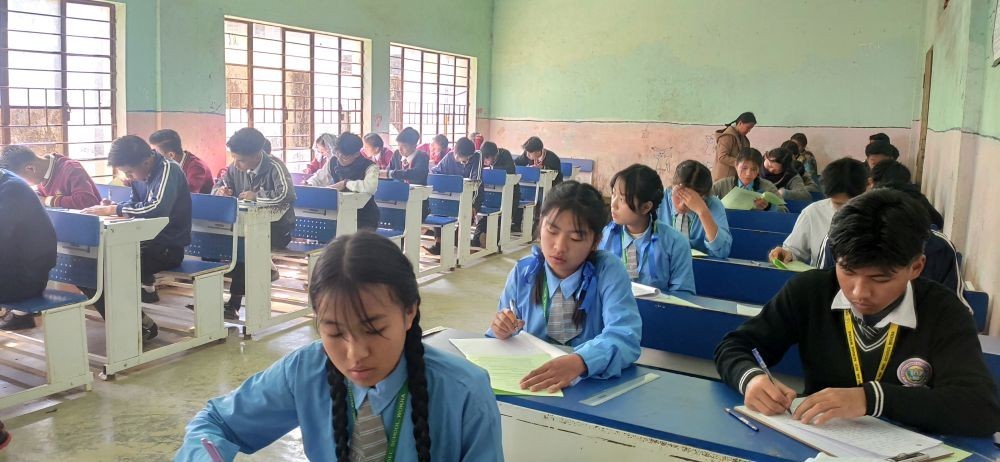
Dimapur | January 11
Morung Express News
Women, in Nagaland, definitely have surged past men in academia, particularly in research work.
Besides, more women are attending colleges in pursuit of higher education and graduating with bachelor and master degrees under regular mode than their male counterparts.
The All India Survey on Higher Education (AISHE) 2016-17 report, released by the Human Resource Development (HRD) last week, affirmed the contention that in the echelons of higher education, women are decisively ahead of men in the state.
In Doctor of Philosophy (PhD), considered the highest academic degree awarded by universities in most countries, out of a total current enrolment of 232 scholars in Nagaland, 138 are women and 94 men.
Under Master of Philosophy, the female-male ratio is 9:1 in Nagaland. The all India data for PhD scholars is 81795 males and 59242 females respectively, out of total 141037 current enrollments.
In Post Graduate (PG/MA) degree, it was evenly poised with 2968 male and 2824 out of current total enrolment of 5792 students. However, in regular mode, women again outshine men with 1403 and 951 enrollment respectively. Overall, there are currently 40762 registered students for various courses in higher education with 20192 men and 20570 women. In regular mode, out of 35120 persons, 18317 are women while 16803 are men, according to the AISHE data.
Overall Scenario: According to the data, the State of Nagaland in the year 2016-17 had 4 Universities – 1 central and 3 State private Universities. The number of universities in the country rose to 864 last year as compared to 799 in 2015-16. There were 64 colleges in Nagaland, out of which 43 were private (Un-aided – 8 and aided – 35) and 21 Government Colleges.
In 2010-11, there were only 52 colleges, which rose to 65 in 2016-17. The enrollment and Private and Government College were 20117 and 10000 persons respectively. Specifically, the state had 51 general colleges; 6 for Education and Teacher Education; Engineering and Technology -1; Law – 3, Nursing -1; and others – 2. There was also one Institute of National Importance – NIT, Dimapur. In addition, there were 16 Stand Alone Institutions—4 Polytechnics; 3 Nursing; and 9 Teacher Training Institutions. These institutions, as per HRD norms, are not empowered to provide degree and therefore run Diploma Level Programmes.
With 64 colleges, the number of colleges per lakh population (between 18-23 years) in Nagaland comes to 26, slightly below all India average of 28. The ratio, however, has gradually increased from 20 in 2010-11. In 2016-17, the population (between 18-23 years) in Nagaland was 255957 persons with 125144 males and 120813 females.
With that, the Gross Enrollment Ration (GER), the total enrolment in higher education among the age group of 18-23, was 16.6 - 16.1 male and 17.0 female - reflecting a robust Gender Parity Index (GPI) of 1.63 against India’s average of 0.94. It was only 0.65 in 2010-11.
GPI (male to female ratio in higher education) is used to measure progress towards gender equity and the level of learning opportunities available for women in relation to those available to men and calculated for 18-23 years age group.
India has also an aggressive target of achieving 30 per cent GER in higher education by 2020. Interestingly, Nagaland has failed to attract any foreign students so far, unlike other North Eastern States.
Among the NE states, Sikkim has the highest foreign student enrollment at 339 followed by Assam at 184; and Meghalaya at 160. Manipur and Mizoram had 8 and 7 respectively, while data for Arunachal Pradesh is missing in the AISHE’ data.
Faculty scenario: The gradual surge of female academicians in Nagaland in recent years is reflected by data on faculty strength Overall, there were all together 2193 teachers teaching at various level of higher education. Out of this, 993 were men while 1205 were women. There were also 2 differently abled (PWD) faculty members.
For instance, for professors and equivalent, relatively older positions, males outnumber females decisively at 108 and 45 respectively, out of a total of 203.
However, for the posts of Readers and Associate Professors, the data is reversed. Out of 263, 138 were women and 125 were men.
As far as Lecturers and Assistant Professors are concerned, women were way ahead of men at 955 and 701 respectively out of 1656 positions.
Ditto for M- Tutors/Demonstrators (85) with 31 males and 54 females occupying those positions.
The Pupil-Student Ratio in Nagaland was also robust at 1:16 (under regular mode), while it was 26 nationally.
Looking at the Student enrollment at various levels in the last 7 years, the data shows a decline by 27.71% from 56389 in 2010-11 to 40762 in 2116-17.


.jpg)
.jpg)
.jpg)
